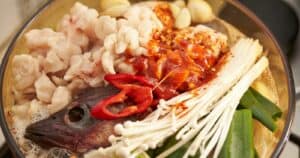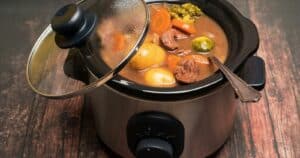Having friends over for hot pot but not sure where to start? With so many ingredients and steps, whipping up this tasty Asian dish can seem daunting. But with a few tips and tricks, you’ll be hosting a delicious hot pot party in no time.
The key to great hot pot is all about the prep work. Start by gathering your broth ingredients – chicken or vegetable stock provides a flavorful base. Then chop up an assortment of raw meats and seafood like thin slices of beef, pork, shrimp and fish balls. Marinate them in a bit of oil, soy sauce and cornstarch for extra flavor. Don’t forget the veggies! Thinly slice mushrooms, bok choy, napa cabbage and whatever other fresh produce you enjoy.
Once your ingredients are prepped, it’s time to set up your portable burner and pot. Fill the pot about 2/3rds with broth and bring to a gentle simmer. Arrange your ingredients in plates around the pot. Then invite everyone to grab their own small strainers and cooking utensils.
The fun is dipping your ingredients into the simmering broth to cook. Start with quick-cooking items like veggies and fish balls, then move to thinly sliced beef or pork. Dip, swish and eat – going back for more as you please. Add more broth as needed.
Hot pot is all about savoring the communal, do-it-yourself dining experience. With a little planning, you’ll be ready to host a fantastic hot pot gathering. Just sit back, relax and enjoy the flavors.
Pick Your Broth
The foundation of hot pot is the simmering pot of broth. You can use chicken, beef or vegetable broth. For a richer flavor, opt for bone broth. Some other tasty broth options include:
- Miso Soup Base: Mix miso paste with dashi stock for a savory Japanese-inspired broth.
- Tom Yum Soup: Use lemongrass, kaffir lime leaves, chilies and lime juice for a Thai tom yum flavor.
- Spicy Mala Broth: Sichuan peppercorns, chilies and numbing Sichuan peppercorn oil give this Chinese broth its addictive tongue-numbing heat.
- Kimchi Stew: For a Korean hot pot, use kimchi and pork belly.
No matter what broth you choose, be sure to make extra so you can replenish the pot as needed. Aim for about 8-10 cups of broth in your pot.
Must-Have Hot Pot Ingredients
The variety of dip-and-eat ingredients is what makes hot pot such a fun meal. Offer an assortment of meats, seafood, veggies and starches so guests can customize their dining experience. Here are some must-have ingredients:
Thinly Sliced Meats
- Beef – ribeye, sirloin, flank steak
- Pork – shoulder or loin
- Lamb – leg or shoulder chops
- Chicken breast
- Duck breast
Slice meats very thinly against the grain. Partially freeze meat for easier slicing.
Fresh Seafood
- Shrimp
- Scallops
- Squid rings
- Fish fillets or balls
- Clams or mussels in shells
Seafood cooks quickly, so it’s best added last.
Veggies
- Bok choy
- Napa cabbage
- Spinach
- Mushrooms
- Bean sprouts
- Broccoli florets
- Asparagus spears
- Green onions
For easier eating, cut veggies into bite-sized pieces before guests arrive.
Starches and Tofu
- Rice cakes
- Rice noodles
- Potato slices
- Tofu cubes or sheets
- Fish tofu
- Fish balls
- Dumplings
Starchier items can soak up flavors from the broth.
Extras
- Sesame oil
- Soy sauce
- Chile oil
- Garlic
- Ginger
- Cilantro
- Scallions
- Peanuts
- Sesame seeds
Provide small dishes of extras so guests can customize their cooked morsels to taste.
Equipment Needed
Having the right gear will make your hot pot experience smooth and safe. Here’s what you’ll need:
- Portable Butane Burner – This provides the consistent flame needed to keep the broth simmering. Choose one with adjustable temperature controls.
- Stock Pot – Use a medium to large-sized pot to hold all the broth. Aim for 8 quarts or larger. Pick a pot with thin, conductive walls.
- Noodle Baskets – These metal baskets make it easy to dip and cook noodles or dumplings.
- Cooking Chopsticks – Provide chopsticks for guests to use when cooking their items in the broth.
- Small Bowls – Individual dipping bowls allow guests to customize sauces.
- Cooking Oil – Grease the pot surface with a bit of oil to prevent ingredients from sticking.
- Ladle – Use a ladle to scoop and pour broth into dipping bowls.
- Tongs – Long cooking tongs help guests pick up cooked items from the pot.
Prep Your Ingredients
Having everything prepped in advance is crucial for smooth hot pot flow during the party. Here are some tips:
- Slice meats as thinly as possible, against the grain for tenderness.
- Partially freeze meat for 30 minutes first to make slicing easier.
- Cut vegetables into small, uniform pieces for quick cooking.
- Soak rice noodles and rice cakes in warm water for 10 minutes until pliable.
- Whisk sauces like sesame oil, soy, hoisin in small dipping bowls.
- Mix cornstarch with sliced meats for a velveting effect.
- Arrange ingredients neatly on platters for easy access during cooking.
Create a Hot Pot Sauce Bar
One of the best parts about hot pot is the customizable dipping sauces. Offer an array of condiments so guests can mix and match flavors. Some sauce bar ideas:
- Soy Sauce – Regular and low-sodium
- Chile Oil – Add garlic, sesame oil, chile flakes
- Sesame Oil – Toasted sesame oil for nutty flavor
- Rice Vinegar – Seasoned rice vinegar varieties
- Hot Sauces – Chili garlic, sambal, sriracha
- Hoisin Sauce – Sweet and salty
- Oyster Sauce – Savory umami flavor
- Peanut Sauce – For a Thai influence
- Ponzu – Citrusy Japanese sauce
- Ginger – Fresh grated ginger
- Garlic – Minced garlic
- Scallions – Thinly sliced scallions
Let guests combine their preferred sauces in individual dipping bowls. Provide small spoons for mixing and tasting sauces.
Set the Hot Pot Table
A hot pot table setup should allow easy access to all ingredients and sauces. Here are some tips:
- Place portable burner at center of table.
- Surround pot with platters of ingredient offerings.
- Offer dipping sauce ingredients in small bowls for mixing.
- Set a bowl of cooked rice or noodles at each place setting.
- Provide individual broth bowls and cooking utensils.
- Include plates for cooked items once they come out of the pot.
- Set platters on hot pads to protect table from heated surfaces.
Having organized stations helps ensure a smooth dining experience.
Time to Eat Hot Pot!
Once everything is prepped and setup, it’s time for the fun to begin! Here’s a step-by-step guide to enjoying the communal hot pot meal:
- Heat broth in pot until simmering. Ladle broth into individual dipping bowls.
- Show guests how to use cooking chopsticks and strainers.
- Start cooking! Have guests add quick-cooking items like veggies and fish balls first.
- Add thinly sliced meats, swirling briefly until cooked through.
- Let guests customize cooked items with preferred sauces.
- Once broth starts to boil, lower temperature to maintain a gentle simmer.
- Use ladle to periodically replenish broth from reserve stocks.
- Cook rice noodles, dumplings or other starches in batches as desired.
- Let guests continue cooking and dipping for as long as they wish!
- Adjust broth seasoning as needed. Add more garlic, herbs or chili oil if desired.
- Once ingredients are cooked, guests can take cooked items from the pot and enjoy on their individual plates.
Frequently Asked Questions About Hot Pot
Still have some questions about hot pot after reading the main article? Below are answers to 5 of the most common hot pot FAQs:
Q: What’s the best broth for hot pot?
A: The broth is really a matter of personal preference. Popular bases include chicken, miso, tom yum, mala
Q: How do you keep hot pot ingredients from sticking to the pot?
A: Lightly rubbing oil on the pot interior helps prevent sticking. You can also stir ingredients frequently as they cook. Scooping them out quickly once cooked also helps minimize sticking.
Q: Is hot pot healthy?
A: It can be! Focus on lots of veggies along with lean proteins and minimal added oils or fatty meats. Go easy on fatty dipping sauces as well. The broth can absorb nutrients from ingredients cooked in it.
Q: What if hot pot broth gets too salty?
A: Adding a peeled, lightly smashed potato to the broth can help absorb some excess saltiness. You can also dilute the broth with a bit of water or extra stock if needed.
Q: How long can hot pot broth stay out?
A: For food safety, discard hot pot broth after 2 hours maximum at room temperature. To enjoy leftovers, transfer broth to a storage container in the fridge to use within 3-4 days. Reheat fully before using again.
The joy of hot pot lies in savoring the communal, interactive dining experience. Follow these tips for hot pot success at your next dinner party!





